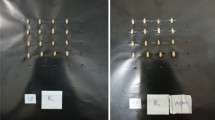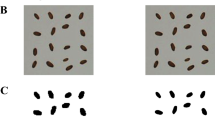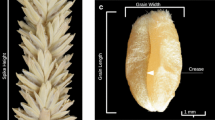Abstract
Three types of experiments were carried out. In the first series of experiments emmer wheat grains (Triticum dicoccum Schübl), var. AR, and peas (Pisum sativum L.), var. RE, were heated at temperatures ranging from 130–700 °C under controlled anoxic conditions for a maximum of 120 min. For each temperature a separate experiment was carried out in a pre-heated tube oven. Image acquisition was carried out on a flat bed scanner with a transparency adapter; for the analysis the image program IMAGE J 1.27 was used. Various size and shape factors are discussed and the definitions of the selected size and shape factors are given. The size and shape were measured and the mean calculated from thirty of the untreated specimens and the charred residues heated at each temperature. The results show a change of size and shape as a function of the temperature. The changes for wheat grains and peas are not identical. It is suggested that the presence of the pericarp enclosing the wheat grains causes this difference. In a second series of experiments it was shown that untreated grains of emmer wheat, bread wheat and macaroni wheat can be separated by measuring the shape, but size varies too much within each species, probably the result of different growing conditions, to be useful for separation purposes. As a result of heating at temperatures higher than 290 °C the shape of the three species becomes identical. This implies that the three species can no longer be separated after being heated, solely on the basis of size and shape. Finally, both emmer wheat grains enclosed by chaff and without chaff were heated under similar conditions. After removal of the chaff from the former, the size and shape of the grains were measured. The results show no significant difference in size and shape between both types.








Similar content being viewed by others
References
Bannur, S.V., Kulgod, S.V., Metkar, S.S., Mahajan, S.K., Sainis, J.K. (1999). Protein determination by Ponceau S using digital colour image analysis of protein spots on nitrocellulose membranes. Analytical Biochemistry, 267, 382–389
Braadbaart, F., Boon, J.J., Veld, H., David, P., Bergen, P.F. van (2004a). Studies on the heat treatment of peas: changes of their physical and bulk chemical properties. Journal of Archaeological Science, 31, 821–833
Braadbaart, F., Boon, J.J., Horst, J. van der, Bergen, P.F. van (2004b). Laboratory simulations of the transformation of peas as a result of heating: the change of the molecular properties by DTMS. Journal of Analytical and Applied Pyrolysis, 71, 997–1026
Braadbaart, F., Horst, J. van der, Boon, J.J., Bergen, P.F. van (2004c). Laboratory simulations of the transformation of emmer wheat as a result of heating. Journal of Thermal Analyses and Calorimetry, 77, 957–973
Braadbaart, F., Bakels, C.C., Boon, J.J., Bergen, P.F.van (2004d). Heating experiments under anoxic conditions on varieties of wheat. Archaeometry, 47, in press
Hillman, G.C., Wales, S., McLaren, F., Evans, J., Butler, A. (1993). Identifying problematic remains of ancient plant foods: a comparison of the role of chemical, histological and morphological criteria. World Archaeology, 25, 94–121
Hillman, G.C., Mason, S., Moulins, D. de, Nesbitt, M. (1996). Identification of archaeological remains of wheat: the 1992 London workshop. Circaea, 12, 195–209
Hopf, M. (1955). Formveränderungen von Getreidekörnern beim Verkohlen. Berichte der Deutschen Botanischen Gesellschaft, 68, 191–193
Hubbard, R.N.L.B. (1992). Dichotomous keys for the identification of the major Old World crops. Review of Palaeobotany and Palynology, 73, 105–115
Jacomet, S. (1987). Prähistorische Getreidefunde. Eine Anleitung zur Bestimmung prähistorischer Gersten- und Weizenfunde, Basel
Kislev, M.E., Rosenzweig, S. (1989). Influence of experimental charring on seed dimensions of pulses. Acta Interdisciplinaria Archaeologica, 7, 143–157
Sapirstein, H.D., (1995). Varietal identification by digital analysis. In: Wrigley C.W. (ed) Identification of food-grains varieties. American Association of Cereal Chemists Inc, St. Paul, MN, 91–130
Shouche, S.P., Rastogi, R., Bhagwat, S.G., Sainis, J.K. (2001). Shape analysis of grains of Indian wheat varieties. Computers and Electronics in Agriculture, 33, 55–76
Singh, N., Singh, J., Kaur, L., Singh Sodi, N., Singh Gill, B. (2003). Morphological, thermal and rheological properties of starches from different botanical sources. Food Chemistry, 81, 219–231
Smith, H., Jones, G. (1990). Experiments on the effects of charring on cultivated grape seeds. Journal of Archaeological Science, 17, 317–327
Symons, S.J., Fulcher, R.G. (1988). Determination of wheat kernel morphological variation by digital image analysis: I. Variation in Eastern Canadian milling quality wheats. Journal of Cereal Science, 8, 211–218
Whitworth, M. (2000). Heterogeneity of structure and grain composition. In: Workshop on Process Engineering of Cereals 1999, Montpellier
Wright, P.J. (1998). The making of the carbonized macrobotanical record. Dissertation Washington University, St. Louis, USA
Zeist, W. van (1970). Prehistoric and early historic food plants in the Netherlands. Palaeohistoria, 14, 41–173
Zohary, D., Hopf, M. (2001). The domestication of plants of the Old World. Oxford University Press, Oxford
Acknowledgements
The authors are grateful to B. Marino (FOM Institute for Atomic and Molecular Physics, Amsterdam, The Netherlands) for her suggestions regarding digital imaging analysis. Practical help with the microphotographs of wheat grains by E. Mulder (Faculty of Archaeology, Leiden University) is gratefully acknowledged.
Author information
Authors and Affiliations
Corresponding author
Rights and permissions
About this article
Cite this article
Braadbaart, F., van Bergen, P.F. Digital imaging analysis of size and shape of wheat and pea upon heating under anoxic conditions as a function of the temperature. Veget Hist Archaeobot 14, 67–75 (2005). https://doi.org/10.1007/s00334-004-0050-y
Received:
Accepted:
Published:
Issue Date:
DOI: https://doi.org/10.1007/s00334-004-0050-y




